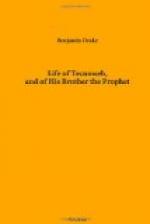[Footnote A: Doddridge’s Indian Wars.]
There have been various speculations as to the causes which induced governor Dunmore to order the retreat of the army under general Lewis, before the treaty was concluded. However desirous of a peace, the presence of an additional force would only have rendered that result more certain. It was believed by some of the officers of the army, and the opinion has been held by several writers since, that after governor Dunmore started on this expedition, he was advised of the strong probability of a war between Great Britain and her colonies; and that all his subsequent measures were shaped with a reference to making the Indians the allies of England in the expected contest. On this supposition, his conduct in not joining general Lewis at the mouth of the Kanawha, in risking his own detachment in the enemy’s country, and in positively forbidding the other wing of the army from uniting with his, at camp Charlotte, has been explained. There are certainly plausible grounds for believing that governor Dunmore at this time, had more at heart the interests of Great Britain than of the colonies.
Soon after the conclusion of this war, the Shawanoes, with other tribes of the north-western Indians, took part with England in the war with the colonies; nor did the peace of 1783 put an end to these hostilities. The settlement of the valley of the Ohio by the whites, was boldly and perseveringly resisted; nor was the tomahawk buried by the Indians, until after the decisive battle at the rapids of the Miami of the lakes, on the 20th of August, 1794. The proximity of the Shawanoe towns to the Ohio river—the great highway of emigration to the west—and the facility with which the infant settlements in Kentucky could be reached, rendered this warlike tribe an annoying and dangerous neighbor. Led on by some daring chiefs; fighting for their favorite hunting-grounds, and stimulated to action by British agents, the Shawanoes, for a series of years, pressed sorely upon the new




